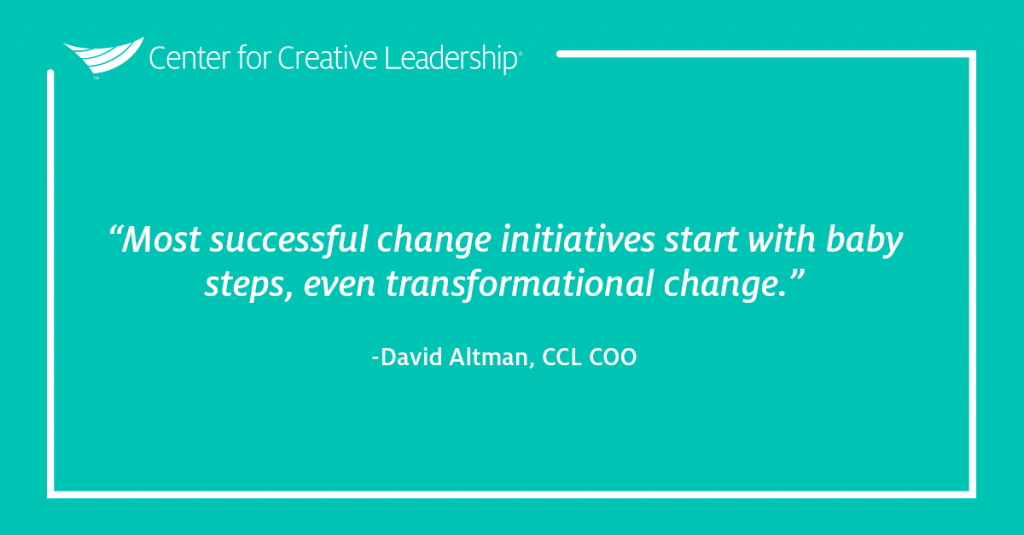Foster an Innovative Culture by Overcoming Change Fatigue & Embracing Change
The idea that there’s a quick fix for culture can cause lots of problems. Cultural change is what you get after you’ve put new processes or structures in place, and it evolves slowly, along with the organization.
It’s challenging to get employees to embrace change — they may feel they’re constantly told they need to change processes and practices, only for the leadership team to keep on doing what they always do, and for managers to maintain the same old routines. Despite an initial surge of enthusiasm, nothing ever changes.
The irony is that “change fatigue” can set in, despite “the way we do things around here” remaining very much the same.
Change fatigue is one of the top 2 challenges leaders face when building organizational cultures, we found in a survey with corporate leaders. Other research has found that change initiatives flounder because companies lack the skills to sustain and embrace change over time.
When the reasons and need for change are poorly communicated, everyone feels frustrated and deflated.
Combine with that the fact that all changes, even positive ones, come at a cumulative cost for your workforce.
Build Change Resilience & Overcome Change Fatigue in the Workplace
How to Get Employees to Embrace Change & Avoid Change Fatigue
Change is constant now. What leaders must do is to help employees and managers recalibrate their expectations. This is the world we live in now — change is constant. There’s no ‘getting back to normal.’
The message from leaders needs to be: ‘Let’s get ourselves in shape as individuals and as an organizational culture to embrace the opportunities and to manage the challenges of constant change in the dynamic world that we live in. Let’s equip ourselves together to become more resilient to accommodate that.’”
Leaders can help employees — and themselves — embrace change and overcome change fatigue by taking the following steps:
- Help the organization continually prioritize change efforts, and focus on the change initiatives that are the highest priority.
- Recognize and talk about how change is both the beginning of something new and the ending of something that previously was embraced as a best practice.
- Teach employees evidence-based techniques for managing stress, building resilience, and deploying coping skills in the face of high demands. Build organizational resilience, too.
- Focus on building a psychologically safe culture in which people can take interpersonal risks by speaking their truths. Psychological safety is critical for candid conversations.
The last step will help leaders understand the challenges and opportunities that exist throughout the organization, which in turn will help leaders be more effective in leading their teams through change.
To Ditch Change Fatigue, Help People View Change as Continual Evolution
Consider the experience of a large company in the energy sector attempting to reinvent itself in the face of volatile market conditions.
In the VUCA (Volatile, Uncertain, Complex, and Ambiguous) world of energy — with shifting oil and gas prices, competition, government policies, and so on — what worked in the past doesn’t work anymore, which was just generating energy and selling it at a good price. It’s also not just about hiring more good engineers, as they’re typically trained to identify problems and come up with a solution and are steeped in LEAN and Six Sigma. But they’re not set up to take risks, to have innovative mindsets, and try new things out.
Across all industries, many traditional, hierarchical global companies struggle to innovate and adapt with sufficient speed and, as a result, must change their mindsets about what’s needed to survive and thrive in the new world order.
Legacy organizations with ingrained cultures have to understand that there is no endpoint — there’s just continual evolution. The ability to be innovative and flexible is directly linked to the ability to seek new opportunities and embrace change.
The reality is, change is complex and continuous. Organizations must help their workers to embrace the opportunities of change and to manage the challenges of constant disruption. That may be a tough message for leaders to deliver, but it need not be a harsh reality.
Rather than focusing on help team members in overcoming “change fatigue,” focus on helping them develop change energy and learning agility. Most successful change initiatives start with baby steps, even large, transformational ones.
With the right leadership, it’s an exciting and galvanizing message for your workforce. Generating excitement around new initiatives and creating a learning culture helps organizations and their employees ditch the change fatigue and truly embrace continual disruption and innovation.
Ready to Take the Next Step?
Do your leaders react to change, rather than proactively lead it? Enable them to go beyond change management and become change leaders who can overcome change fatigue and build greater organizational change resilience. Partner with us to create a customized learning journey for your leaders using our research-based modules. Available leadership topics include Emotional Intelligence, Innovation Leadership, Leading Through Change, Psychological Safety, Resilience-Building and more.










